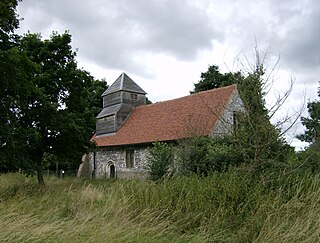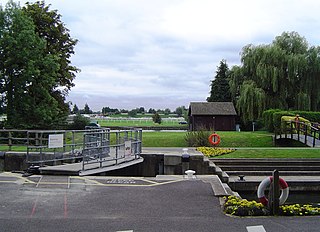
Slough is a town in Berkshire, England, in the Thames Valley 20 miles (32 km) west of central London and 19 miles (31 km) north-east of Reading, at the intersection of the M4, M40 and M25 motorways. It is part of the historic county of Buckinghamshire. In 2021 Census, the population of the town was 143,184. In 2021, the wider Borough of Slough had a population of 158,500. Slough borders the ceremonial counties of Greater London and Buckinghamshire.

The Royal County of Berkshire, commonly known as simply Berkshire, is a ceremonial county in South East England. It is bordered by Oxfordshire to the north, Buckinghamshire to the north-east, Greater London to the east, Surrey to the south-east, Hampshire to the south, and Wiltshire to the west. Reading is the largest settlement and the county town.

Maidenhead is a market town in the Royal Borough of Windsor and Maidenhead in the county of Berkshire, England, on the southwestern bank of the River Thames. In the 2021 Census, it had an estimated population of 70,374 and forms part of the border with southern Buckinghamshire. The town is situated 27 miles (43 km) west of Charing Cross, London and 13 miles (21 km) east-northeast of the county town of Reading. The town differs from the Parliamentary constituency of Maidenhead, which includes a number of outer suburbs and villages, including villages which form part of the Borough of Wokingham such as Twyford, Charvil, Remenham, Ruscombe and Wargrave.

The Royal Borough of Windsor and Maidenhead is a royal borough and unitary authority in Berkshire, South East England. While it is named after both the towns of Maidenhead and Windsor, the borough also covers the nearby towns of Ascot and Eton. It is home to Windsor Castle, Eton College, Legoland Windsor and Ascot Racecourse. It is one of four boroughs entitled to be prefixed Royal and is one of six unitary authorities in the county, which has historic and ceremonial status.

Datchet is a village and civil parish in the Royal Borough of Windsor and Maidenhead in Berkshire, England, located on the north bank of the River Thames. Historically part of Buckinghamshire, and the Stoke Hundred, the village was eventually transferred to Berkshire, under the Local Government Act of 1972. The village developed because of its close proximity to Windsor and the ferry service which connected it to the main London Road across the River Thames. The ferry was later replaced by a road bridge at the foot of the High Street, which was rebuilt three times. There is also a rail bridge approaching Windsor across the river, and two road bridges above and below the village.

Dorney is a village and civil parish in the Unitary Authority of Buckinghamshire, England, bordering on the River Thames to the west and south, and bisected by the Jubilee River. In 2011 it had a population of 752. It is 2.3 miles (3.7 km) west of neighbouring Eton, which is a slightly larger parish.

Eton is a town in Berkshire, England, on the opposite bank of the River Thames to Windsor, connected to it by Windsor Bridge. The civil parish, which also includes the village of Eton Wick two miles west of the town, had a population of 4,692 at the 2011 Census. Within the boundaries of the historic county of Buckinghamshire, in 1974 it came under the administration of Berkshire following the Local Government Act 1972; since 1998 it has been part of the unitary authority of Windsor and Maidenhead. The town is best known as the location of Eton College.

Boveney is a village and former civil parish, now in the parish of Dorney, in Buckinghamshire, England. It is situated near Windsor, between the villages of Eton Wick in Berkshire, and Dorney and Dorney Reach in Buckinghamshire. Since boundary changes in 1974 and 1995, Boveney is the southernmost village in Buckinghamshire. In 1931 the parish had a population of 630.

Burnham is a large village and civil parish that lies north of the River Thames in Buckinghamshire, between the towns of Maidenhead and Slough, about 24 miles west of Charing Cross, London. It is probably best known for the nearby Burnham Beeches woodland.

Slough is a constituency represented in the House of Commons of the UK Parliament by Tan Dhesi, a member of the Labour Party, since the 2017 UK general election.

Windsor (/ˈwɪnzə/) is a constituency in Berkshire represented in the House of Commons of the UK Parliament since 2005 by Adam Afriyie of the Conservative Party. It was re-created for the 1997 general election after it was abolished following the 1970 general election and replaced by the Windsor and Maidenhead constituency.
Eton Rural District was a rural district in the administrative county of Buckinghamshire, England, covering an area in the south-east of the county. It was named after but did not contain Eton, which was an urban district.
Slough is a town and unitary authority in the English county of Berkshire, just to the west of Greater London. Until 1974 the town was in Buckinghamshire.

Boveney Lock is a lock on the River Thames situated on the Buckinghamshire bank opposite the Windsor Racecourse and close to Eton Wick. Boveney is a village a little way upstream on the same side. The lock was first built in 1838 by the Thames Navigation Commission. The lock was rebuilt in 1898 closer to the Buckinghamshire bank, and a set of boat rollers were installed on the old site.
The town of Eton formed a local government district in Buckinghamshire, England from 1849 to 1974. It was administered as a local board district from 1849 to 1894, and as an urban district from 1894 to 1974.

Slough was, from 1863 to 1974, a local government district in southern Buckinghamshire, England. It became an urban district in 1894 and was incorporated as a municipal borough in 1938. It was abolished in 1974 and now forms part of the borough of Slough in Berkshire.

Eton and Castle is an electoral ward of the Royal Borough of Windsor and Maidenhead. As its name suggests, it comprises the town of Eton and Windsor Castle. It is currently represented by George Fussey of the Liberal Democrats. Nationally, the ward forms part of the UK Parliamentary constituency of Windsor and is currently represented by Adam Afriyie of the Conservative Party.
The Windsor and Eton Express was founded on August 1, 1812 by Charles Knight Snr and his son, Charles Knight Jnr. Charles Knight Snr was a local book seller and printer and edited and printed the newspaper from Church Street in Windsor. When Charles Knight Snr died the paper was passed to his son, who was unhappy with the cost of the newspaper, which was six-and-a-half pence when it began and rose to seven pence in September 1815 due to a heavy stamp duty. Charles Knight Jnr believed in a cheap press, but at the start of the Express newspapers were only ever subscribed to by the wealthy, before the abolition of stamp duty in 1855.


















